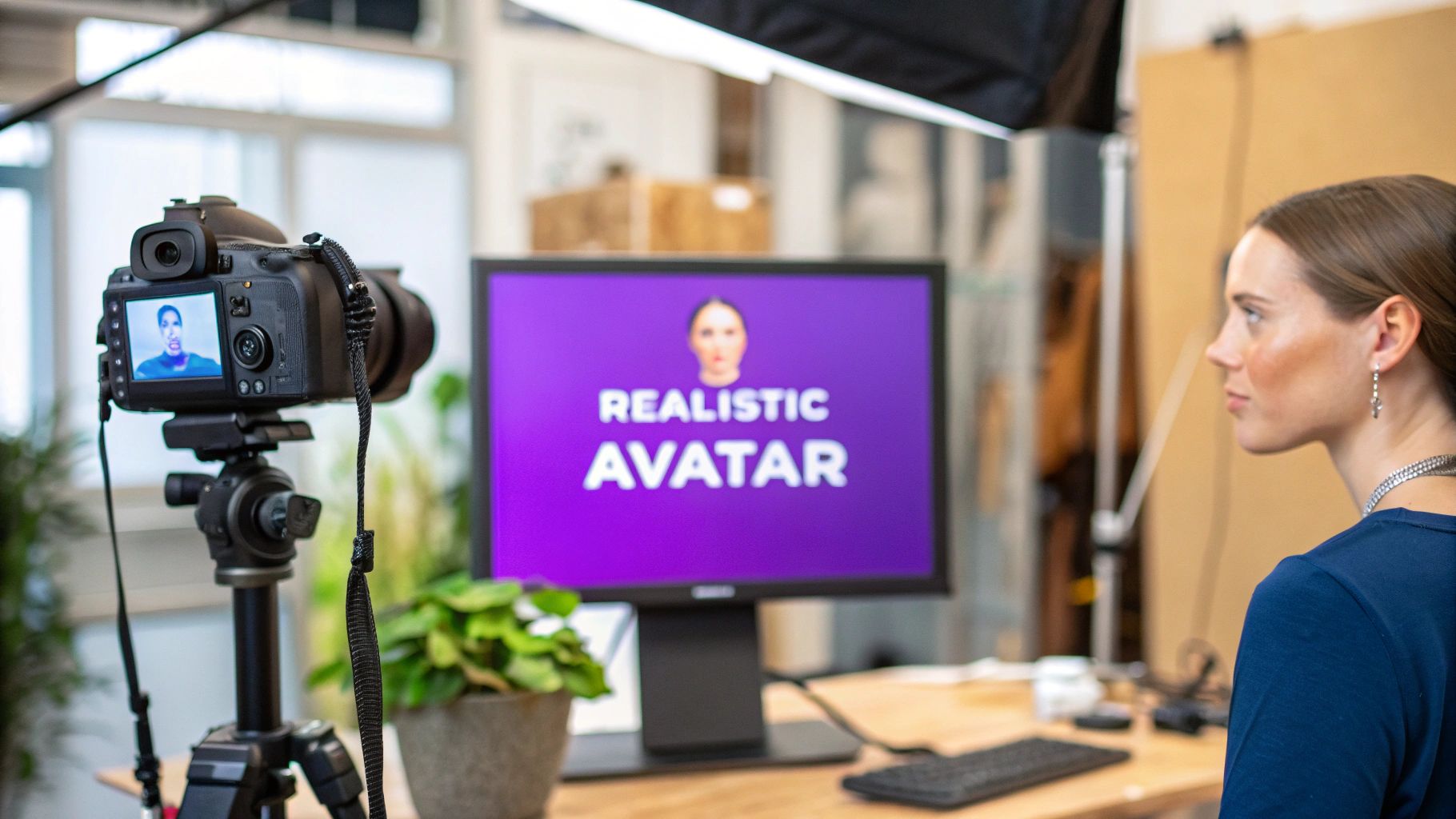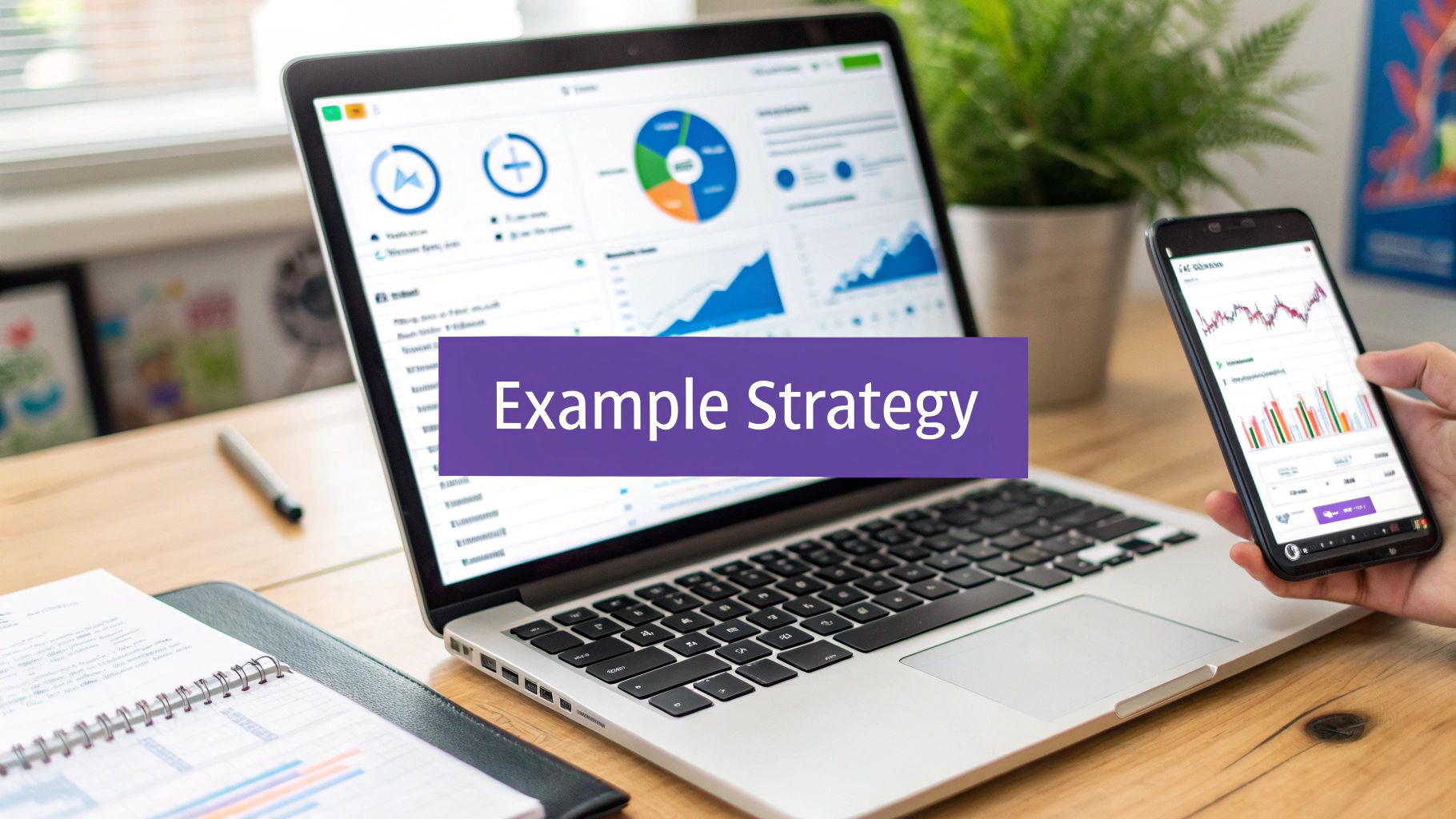7 Essential Career Change Tips for a Successful 2025 Pivot

Contemplating a career change can feel like standing at the edge of a vast, uncharted territory—exciting yet daunting. The traditional career ladder is evolving into a more dynamic 'career lattice,' where moving sideways is as valuable as moving up. This shift means more professionals are seeking new paths that offer greater fulfillment, better work-life balance, or alignment with their true passions.
A successful transition is not about taking a blind leap of faith; it is a strategic process of introspection, planning, and decisive action. For those contemplating a significant pivot, exploring comprehensive guides like Changing Careers Midlife: Your Guide To A Fresh Start can offer valuable initial direction. However, to truly execute a successful move, you need a detailed, actionable plan.
This comprehensive guide moves beyond generic advice to provide a concrete roadmap. We will unpack seven critical career change tips, from self-assessment and strategic networking to financial planning and pilot projects. Each point is designed to build upon the last, creating a holistic framework that transforms uncertainty into a well-executed strategy for a more rewarding professional life. Let's begin the journey of architecting your next great career move.
1. Lay the Groundwork: Master Self-Assessment and Your Skills Inventory
Before you can map a route to a new career, you must understand your precise starting point. A thorough self-assessment is the foundational first step, moving far beyond a simple list of past job duties. This process involves a deep dive into your skills, core interests, professional values, and personality, forming a strategic blueprint for your transition. One of the most critical career change tips is to build this foundation first, as it prevents you from pursuing roles that look good on paper but are a poor fit in reality.

This introspective work helps you identify transferable skills, the bridge from your current field to a new one. For instance, a teacher might realize their skills in classroom management, curriculum design, and parent communication are highly valuable in corporate training and development. Similarly, a marketing manager who excels at campaign analysis might discover their aptitude for data science.
How to Create Your Skills Inventory
A comprehensive skills inventory documents your capabilities and preferences, creating a clear picture of what you bring to the table and what you need in a role to feel fulfilled.
- Analyze Past Accomplishments: Review old performance evaluations, projects, and personal achievements. For each success, ask yourself: What specific skills did I use? Which parts of this work energized me the most?
- Categorize Your Skills: Group your skills into categories like technical skills (e.g., Python, Adobe Creative Suite), soft skills (e.g., communication, empathy), and management skills (e.g., project management, team leadership).
- Seek External Feedback: Ask trusted mentors, colleagues, or former managers for their honest perspective on your greatest strengths. They often see valuable traits you might overlook.
- Utilize Professional Tools: Assessments like the Gallup CliftonStrengths (formerly StrengthsFinder) or the Myers-Briggs Type Indicator (MBTI) can provide structured, objective insights into your natural talents and work style preferences.
By dedicating time to this self-assessment, you build a reliable compass to guide your job search. This clarity ensures your next move is not just a change, but a strategic step toward a career where you can genuinely thrive.
2. Strategic Networking and Relationship Building
Once you understand your strengths, the next step is to explore the professional world outside your current bubble. Strategic networking is the deliberate process of building and nurturing professional relationships within your target industry. This goes far beyond collecting business cards; it's about creating genuine connections with professionals who can offer insights, advice, and opportunities. For anyone navigating a career transition, mastering this skill is one of the most impactful career change tips, as it turns a cold job search into a warm, referral-driven process.

This approach, championed by figures like Reid Hoffman and Keith Ferrazzi, is about giving before you get. It’s how a finance professional successfully transitions to tech by having informational interviews with fintech leaders they met on LinkedIn. Likewise, a retail manager can join healthcare administration associations to build a new network and find mentors who can guide their entry into that field. These relationships provide invaluable, real-world context that job descriptions and company websites can never offer.
How to Build Your Professional Network
Effective networking is a skill built on preparation, consistency, and genuine curiosity. By approaching it with a clear strategy, you can turn brief interactions into lasting professional alliances.
- Define Your Networking Goals: Don't just network for the sake of it. Set specific objectives, such as "connect with five product managers at SaaS companies this month" or "attend two local tech meetups." This keeps your efforts focused and measurable.
- Lead with Value: The golden rule of networking is to always consider how you can help others first. This could mean sharing a relevant article, offering an introduction from your own network, or providing feedback on a project.
- Master the Follow-Up: A connection is only as good as its follow-up. After meeting someone, send a personalized email or LinkedIn message within 24-48 hours. Reference a specific point from your conversation to refresh their memory and strengthen the connection.
- Leverage Digital Platforms: Use LinkedIn to research professionals in your target roles and companies. Send personalized connection requests that explain why you want to connect. For additional guidance on making these digital connections count, learn more about how to network online.
By strategically building these relationships, you create a support system and an information channel that can accelerate your career change and uncover opportunities you would have otherwise missed.
3. Skill Gap Analysis and Strategic Upskilling
Once you know where you want to go, you must build a bridge to get there. A skill gap analysis is the systematic process of comparing your current skills to the requirements of your target role. This crucial step in your career transition moves you from wishful thinking to a concrete action plan, allowing you to strategically acquire the specific qualifications needed to be a competitive candidate. This is one of the most powerful career change tips because it demystifies the transition process and gives you a clear, manageable roadmap.

This analysis pinpoints precisely what you need to learn. For example, a graphic designer aiming for a product design role might discover a gap in UX/UI principles and prototyping software. Similarly, an operations manager targeting a marketing position may identify a need for a digital marketing certification to understand SEO and paid advertising. This targeted approach ensures your efforts are focused and efficient.
How to Conduct a Skill Gap Analysis
A deliberate analysis and upskilling plan transforms your career change from a leap of faith into a calculated, strategic move. It shows potential employers that you are proactive, committed, and ready to add value from day one.
- Research Target Job Descriptions: Analyze 10-15 job postings for your desired role. Create a list of the most frequently mentioned technical skills (e.g., SQL, Figma), soft skills (e.g., stakeholder management), and qualifications (e.g., PMP certification).
- Create a T-Chart Comparison: Draw a T-chart. On the left, list the required skills you just identified. On the right, honestly assess and list which of those skills you currently possess and at what proficiency level. The empty spaces reveal your gaps.
- Develop a Learning Roadmap: For each identified gap, determine the best way to learn it. Options include online courses, professional certifications, workshops, or volunteer projects. When implementing strategic upskilling to bridge identified gaps, exploring the best certifications for remote jobs can provide a clear pathway to new opportunities.
- Build a Portfolio of Evidence: As you learn, create tangible proof of your new skills. This could be a project on GitHub, a design portfolio, or a case study analysis. This practical evidence is often more compelling to employers than a course certificate alone.
By methodically identifying and filling your skill gaps, you build the competence and confidence necessary for a successful pivot. You can learn more about how to create your own detailed plan for Skill Gap Analysis and Strategic Upskilling at MakerBox.
4. Financial Planning and Transition Preparation
A career change is as much a financial journey as it is a professional one. Neglecting your finances can force you into a rushed decision, pushing you toward a job that pays the bills rather than one that aligns with your long-term goals. Thoughtful financial planning provides a crucial safety net, giving you the freedom and time to find the right opportunity without succumbing to financial pressure. This is one of the most critical career change tips because it empowers you to make strategic, not desperate, moves.

This preparation involves creating a detailed financial runway to cover your expenses during the transition, which might include a period of reduced income, unemployment, or investment in new skills. For instance, a software engineer might create a detailed budget to save aggressively for six months, allowing them to leave their job and focus entirely on building a side business into a full-time venture. Similarly, a marketing executive could start freelance consulting on the side to build a client base and supplementary income before resigning.
How to Prepare Your Finances for a Career Transition
Building a financial bridge to your new career requires a proactive and organized approach. The goal is to create stability and reduce stress, allowing you to focus on your professional development. To make sure your transition is smooth and secure, it's vital to have a solid financial plan in place. For those just starting out, this guide to financial planning for beginners can provide the necessary foundation for managing your money effectively.
- Build a Transition Fund: Aim to save at least six to twelve months' worth of living expenses. Start saving immediately, even small amounts, and automate your contributions to build momentum.
- Create a Transition Budget: Track your current spending meticulously to identify non-essential costs you can cut. This lean budget will be your guide during the transition period.
- Research Future Income and Costs: Investigate the typical salary ranges for your target roles. Factor in new expenses like tuition for certifications, networking events, or professional association fees.
- Plan for Benefits Changes: Your transition may affect your health insurance, retirement contributions, and other benefits. Research your options, such as COBRA or private health plans, and account for these costs.
By creating a robust financial strategy, you transform a potentially stressful leap into a well-managed and confident step forward. Learn more about Financial Planning to ensure you're fully prepared.
5. Strategic Personal Branding and Professional Positioning
In a career change, you aren't just looking for a new job; you are selling a new professional identity. Strategic personal branding is the process of deliberately shaping how you are perceived by others in your target industry. It involves crafting a compelling narrative that connects your past experience to your future aspirations, ensuring that your skills and value proposition resonate with hiring managers in your new field. This is one of the most critical career change tips for standing out in a competitive market where your previous job title might not seem like a direct fit.
This process repositions your expertise to build credibility and visibility. For example, a retail manager shifting into a corporate customer success role should rebrand their experience to highlight "customer journey optimization" and "retention strategy" rather than "in-store operations." Similarly, an accountant aiming for a business analyst position can emphasize their proficiency in "financial modeling for data-driven decision making," making their skills immediately relevant to the new context.
How to Build Your Professional Brand
A strong professional brand ensures your message is consistent, clear, and compelling across all platforms. It’s about controlling your narrative so that employers see your potential, not just your past.
- Define Your Core Message: Develop one or two key messages that communicate your unique value. What problem do you solve for employers in your target industry? Frame your experience around that solution.
- Update Your Digital Footprint: Your LinkedIn profile is your modern-day resume and personal billboard. It must align perfectly with your new career goals. This includes your headline, summary, and experience descriptions. If you need guidance, you can learn more about crafting an effective professional LinkedIn summary.
- Create Relevant Content: Share articles, write posts, or create case studies that demonstrate your knowledge and passion for your new field. Engage authentically with content from industry leaders to build visibility and network connections.
- Ensure Narrative Consistency: Your brand message must be the same on your resume, during interviews, and in networking conversations. This consistency builds trust and reinforces your new professional identity.
By proactively managing your personal brand, you guide the conversation and show employers not just what you've done, but what you are capable of achieving in your new career.
6. Industry Research and Market Intelligence
Once you have a clear picture of your skills and potential career paths, the next step is to become a student of your target industry. Deep industry research and market intelligence move you from being an outsider looking in to a knowledgeable candidate who understands the landscape. This involves a comprehensive investigation into market trends, growth opportunities, key players, cultural norms, and future challenges. Gathering this intelligence is one of the most critical career change tips, as it allows you to speak the language of your new field and make strategic, informed decisions.
This proactive research helps you understand employer needs and position yourself as a solution. For example, a bank employee exploring fintech would discover the importance of user experience (UX) and agile development, allowing them to highlight relevant project management skills. Similarly, a print journalist investigating the digital media landscape can learn about content monetization strategies and the metrics that matter, like engagement and conversion rates. Understanding how to measure success in a new field is crucial.
How to Gather Market Intelligence
Effective research combines multiple sources to build a holistic view of an industry. This knowledge not only prepares you for interviews but also helps you identify the most promising and stable opportunities.
- Become an Avid Consumer of Industry Media: Subscribe to leading industry publications, newsletters, and podcasts. Follow influential thought leaders and top companies on social media platforms like LinkedIn and Twitter to stay updated on real-time conversations and trends.
- Attend Industry Events: Participate in virtual and in-person conferences, webinars, and trade shows. These events are invaluable for learning about emerging challenges and networking with professionals who can offer direct insights.
- Leverage Data Tools: Use platforms like Glassdoor and PayScale for salary benchmarks, company reviews, and insights into workplace culture. This helps you set realistic expectations and evaluate potential employers.
- Engage with the Community: Join industry-specific forums, Slack channels, or LinkedIn Groups. Observing and participating in these communities provides an unfiltered look at the day-to-day realities of the profession.
- Conduct Informational Interviews: Reaching out to professionals for brief, informal conversations is one of the most powerful research tools. It provides firsthand knowledge you can’t find online and helps build your network.
By immersing yourself in your target industry’s world, you transform from a hopeful applicant into a well-informed professional ready to add immediate value. This strategic approach ensures your career change is grounded in reality, not just aspiration.
7. Pilot Projects and Transition Testing
Jumping headfirst into a new career without firsthand experience is a significant risk. One of the most effective career change tips is to "try before you buy" through low-stakes pilot projects. This approach allows you to gain real-world exposure to a new field, test your interest and aptitude, and build relevant skills without quitting your current job. By taking on small-scale work, you can validate your career choice and ensure it aligns with your expectations.
This transition testing is about more than just confirming your interest; it's a strategic way to build a portfolio and professional network. For example, an accountant curious about marketing could volunteer to manage a local nonprofit's social media campaign. A corporate analyst could take on a freelance web design project via a platform like Upwork or Fiverr to see if a developer role is a good fit. These projects provide tangible proof of your capabilities and commitment.
How to Test Your New Career Path
Creating a pilot project strategy involves identifying opportunities to engage with your target field in a controlled, manageable way. This hands-on experience is invaluable for making an informed decision.
- Start with Small, Defined Tasks: Begin with short-term freelance gigs, a single volunteer project, or a small side hustle. An aspiring writer could start by creating blog posts for a friend's business before pursuing larger contracts. This builds confidence and provides early wins.
- Seek Out Structured Opportunities: Look for part-time internships, temporary contract roles, or formal volunteer positions. These often provide mentorship and a clearer view of the day-to-day realities of the job.
- Document Everything: Treat every project like a professional engagement. Keep detailed records of your responsibilities, the tools you used, and the results you achieved. This documentation becomes the foundation of your new resume and portfolio.
- Actively Request Feedback: Ask clients, supervisors, or collaborators for honest feedback on your work. This insight is crucial for identifying skill gaps and areas for improvement before you make a full commitment to the new field.
By using pilot projects, you transform an abstract career idea into a tangible experience. This practical validation minimizes uncertainty and equips you with the confidence and evidence needed to execute a successful career change.
7 Key Career Change Strategies Comparison
| Item | Implementation Complexity 🔄 | Resource Requirements ⚡ | Expected Outcomes 📊 | Ideal Use Cases 💡 | Key Advantages ⭐ |
|---|---|---|---|---|---|
| Self-Assessment and Skills Inventory | Moderate - requires introspection and tools | Low to moderate - time and possible assessments | Clarity on skills and career direction | Early career planning, identifying transferable skills | Builds confidence, reduces poor career choices |
| Strategic Networking and Relationship Building | High - ongoing relationship cultivation | Moderate to high - time and social effort | Access to opportunities and insider knowledge | Career pivots, entering new industries | Unlocks hidden job market, mentorship, referrals |
| Skill Gap Analysis and Strategic Upskilling | High - research and upskilling required | Moderate to high - time, financial investment | Increased competitiveness and validated skills | Career changes needing new skills or certifications | Demonstrates commitment, builds confidence |
| Financial Planning and Transition Preparation | Moderate - disciplined planning | Moderate - time and financial saving effort | Financial security and strategic decision-making | Career transitions with income risk or delayed timelines | Reduces stress, enables calculated risks |
| Strategic Personal Branding and Professional Positioning | High - ongoing branding and content creation | Moderate to high - time and creative effort | Increased visibility and credibility | Career changers needing strong employer appeal | Differentiates you, builds trust and inbound leads |
| Industry Research and Market Intelligence | Moderate to high - extensive information gathering | Low to moderate - time and info resources | Informed career decisions and negotiation prep | Exploring new industries, preparing for interviews | Avoids costly mistakes, identifies growth opportunities |
| Pilot Projects and Transition Testing | Moderate - managing projects and time | Low to moderate - time and possibly minimal costs | Validation of career interests and skill-building | Testing new careers, gaining practical experience | Builds portfolio, income generation, real-world feedback |
Executing Your Pivot: Turning Your Plan into Action
Embarking on a career change can feel like standing at the base of a mountain. It’s an intimidating journey, but the path to the summit becomes clear when you have a map. The comprehensive framework we've explored provides just that, transforming a daunting aspiration into a series of manageable, strategic steps. You are no longer just wishing for change; you are engineering it.
This process begins with a deep, honest Self-Assessment, creating a foundational understanding of your passions, skills, and non-negotiables. From there, you move outward, using Strategic Networking not just to ask for favors, but to build genuine relationships and gather critical intelligence. This intelligence feeds directly into your Skill Gap Analysis, allowing you to pursue Strategic Upskilling with precision, investing time and resources only in the competencies that truly matter for your target role.
From Blueprint to Reality
A plan without resources is merely a dream. That's why Financial Planning is a non-negotiable pillar of this process, creating the runway you need to make your transition without desperation. As you prepare financially, you also build your public-facing identity through Strategic Personal Branding, ensuring that your new professional narrative is clear, compelling, and consistent across all platforms.
The final, crucial phases involve validation and action. Through diligent Industry Research, you confirm that your target field is viable and aligns with your long-term goals. Then, with Pilot Projects and Transition Testing, you dip your toes in the water, gaining priceless real-world experience, building confidence, and validating your choice before taking the final plunge. These aren't just career change tips; they are a cohesive system for de-risking one of the most significant decisions of your professional life.
Your Next Chapter Awaits
Remember, a successful career pivot is rarely a single, dramatic leap. Instead, it’s a sequence of deliberate, well-executed steps. Each informational interview you conduct, each new skill you acquire, and each small project you complete builds momentum. The power lies in this iterative progress.
Don't let analysis paralysis hold you captive. The perfect plan doesn't exist, but a well-structured, adaptable strategy does. You now have the tools to replace uncertainty with action and fear with a clear-eyed confidence. The career you truly want isn't a distant fantasy; it’s an achievable objective waiting for you to execute the first step.
Ready to accelerate your career transition with the latest AI tools and growth strategies? Join the MakerBox community to get a curated selection of actionable marketing tactics and AI-powered resources delivered to you weekly. Our insights are perfect for building your personal brand and executing a data-driven career change.





